How to clean a sofa at home?

Any sofa with constant use will inevitably get dirty. But this does not mean that you need to call specialists for help every time or simply ignore the spot that has appeared. Knowing exactly how to solve the problem will help you deal with any dirt yourself.
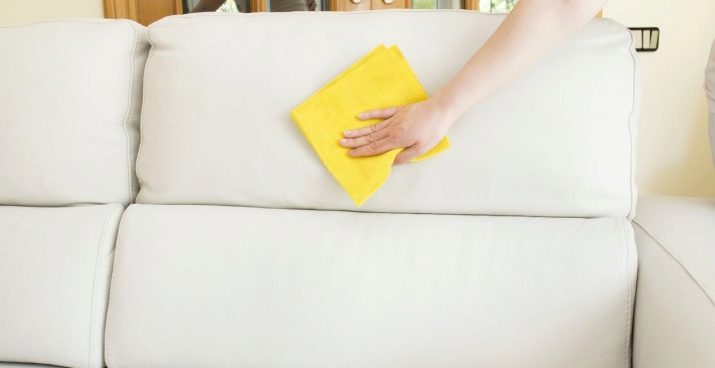
Funds
It can be quite difficult to wash a sofa saturated to the limit with dust with folk remedies. It is more correct to use a regular vacuum cleaner, and to better cope with its task - wrap the attachment in a layer of gauze soaked in an aqueous solution of salt. For a liter of warm water, take 2 or 3 tablespoons of salt, depending on how severe the pollution is.
Such a step will help remove dust and make the upholstery fresher. It is undesirable to vacuum velvet or velor sofas, this can disrupt the normal pile structure.
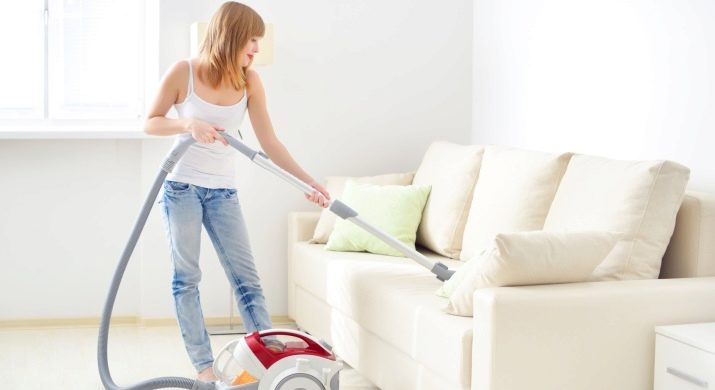
It is also quite possible to cope with dust without a vacuum cleaner. A couple of teaspoons of salt are added to a liter of water at room temperature and 30 grams of vinegar is added. In the prepared composition, an unnecessary old sheet or other fabric is moistened, squeezed so that the surface is only slightly damp. Having spread out the fabric on the sofa, they begin to knock it out, from time to time the fabric is rinsed in clean water.
The lint-free coating is cleaned soapy water with a brush... If the soap doesn't work, try replacing it with dish soap. When you whip up the foam, lubricate the stains with it for 5-10 minutes, then immediately rinse with warm water and dry with a hygroscopic cloth.
Do not try to make the solution as saturated as possible, otherwise you will need to clean out the remnants of the product itself.
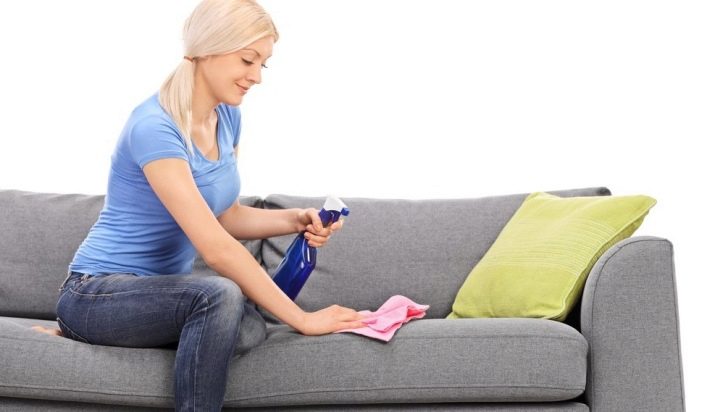
The upholstery with pile is cleaned with a foam rubber sponge, on which the same solutions are applied. Light-colored furniture will have to be washed completely, only under this condition the occurrence of stains is excluded.
You can wash many things yourself with baking soda and vinegar, especially if you add detergent to them. A teaspoon of soda is placed on a liter of water, the same amount of detergent mixed with vinegar. The workpiece is mixed and then applied with a brush to a dirty place. It is advisable to move the brush when cleaning only one way, this will reduce the risk of divorce.
Do not try to create as thick and lush foam as possible, remember, you still have to rinse it off.
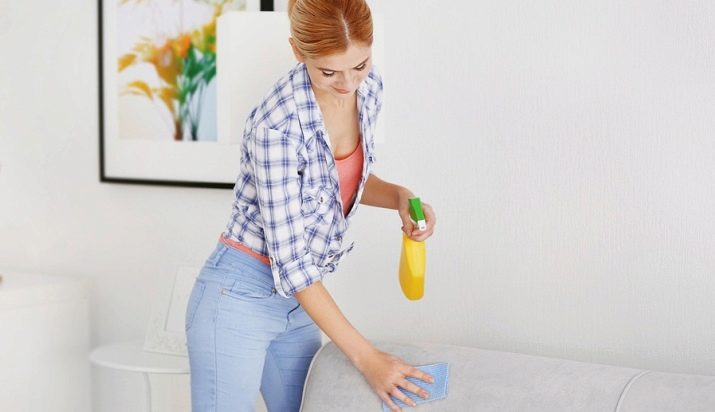
When there is no desire to use powders or to prepare complex mixtures, many stains can be removed quickly at home with Vanish... The drug is dissolved in water (one part of the product for 9 parts of water), then the dirt is gently and without undue effort removed. Using Vanish Oxi Action, you will be able to remove fresh dirt from various products, but this remedy is bad for silk and skin.
The amount of solution specified in the instructions must be whipped and foam is obtained. Then, using a brush, this foam is used to lubricate not only the stain itself, but also the tissue adjacent to it. Within a few minutes, most of the dirt will turn pale, and after a quarter of an hour it will be impossible to notice them. Then all that remains is to dry the sofa, and the problem is completely solved.
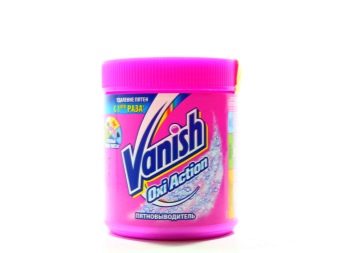
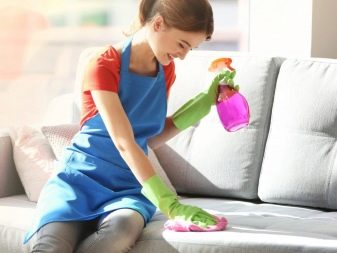
The surest way to get rid of fruit or juice stains is to use ammonia. It is mixed with vinegar in equal proportions (both components take no more than 30 or 40 grams), after applying the solution to the stain, they wait for drying and wash the problem area with warm water.
The remaining stains are removed by repeated cleaning with the same product, but this should be done as carefully as possible.
Ammonia can be dangerous, all manipulations with it are carried out with rubber gloves, be sure to wear a gauze bandage or a respirator on your face. Do not self-medicate if you experience dizziness or burns.
The same ammonia can be used in another way: one part of the reagent is mixed with one part of water, smeared with a sweet spot and allowed to dry, after which the remainder is washed off with clean water. Older dirt is also removable, but you will have to wait 40 minutes. Residual moisture is removed from the upholstery by pressing a dry towel for a few seconds.
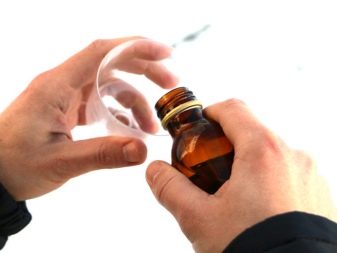
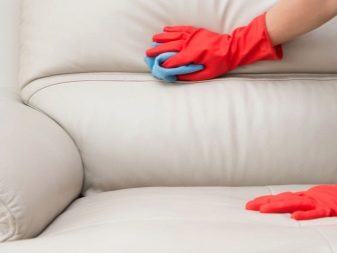
Hydrogen peroxide can remove fresh blood stains; keep wipes ready when cleaning to remove rising foam and prevent it from staining other areas. Peroxide should be added until the stain completely disappears, when it disappears - wipe the problem area with a damp cloth and dry it.
If you need to clean colored fabric, it is better to look for another product, a proprietary stain remover.
Water copes with many pollution, but it should be used only with full confidence in the end result. Stubborn stains, with rare exceptions, cannot be removed with water alone.
Using a steamer, you can not only cope with various types of dirt, but also refresh the sofa to its original state. A stream of heated gas will disinfect the furniture and will be able to expel all unnecessary odors from it. But keep in mind that you may not be able to use the sofa as usual right away, it must dry completely first.
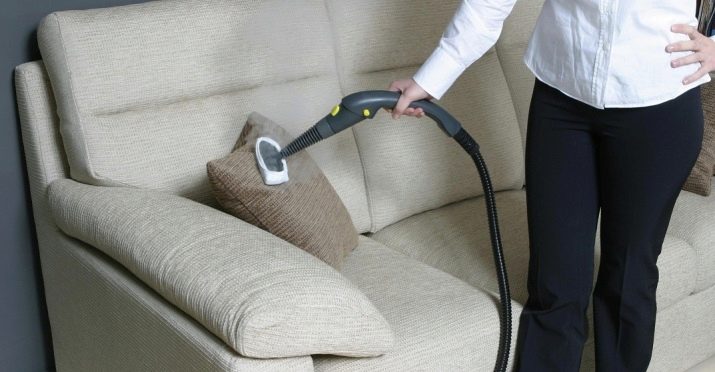
We remove stains correctly
You should be careful to clean the soft sofa at home, since many products, if used ineptly, will only harm. And the drug that helped in one case often turns out to be powerless in another situation, in spite of any diligence. First of all, there are three points to clarify:
- what stain are you dealing with;
- it is fresh or already ingrained;
- features of the upholstery of the product (depending on them, sometimes certain methods cannot be used).
Whichever product is chosen, it must be applied to the entire contaminated surface. It is advisable to use a soft brush, it will improve the contact between the preparation and the dirt. Whether it was possible to cope with fresh pollution, it becomes clear after 15 minutes, and old stains sometimes make you wait for an hour. Until the cleaning agent 100% saturates the stain and reacts with the dirt, wash it off prematurely.
It is unacceptable to use brushes with coarse bristles or simultaneously use two or more cleaning compounds.

Methods for removing contamination
The following recipes can help housewives:
- Baking soda can effectively remove the grease stain. Powder is sprinkled on fresh dirt, which is distributed as evenly as possible. After about five minutes, the soda that has absorbed the fat is collected with a brush, and the fabric itself is moistened and dried. The chewing gum should be carefully peeled off (torn off, scraped off); if a stain remains after it, it is removed with liquid soap and acetone. There is another way: the gum is cooled with an ice pack or something frozen, and then it is simply cleaned up with a knife.
- Instead of a knife, you can take a nail file, toothpick, chisel. The last residues are cleaned with dry napkins or soft-bristled brushes, if necessary, washed with cold water. Similar methods will help remove the paraffin crust. If tea or coffee is spilled, then you need to use soapy foam or prepare a solution based on vinegar and soda.
- Bloody traces are removed with laundry soap dissolved in water, and dried drops can be easily cleaned with a salt solution with exposure for an hour. It can be replaced with aspirin (a tablet in a glass of water). Fresh blood stains are removed with a paste of talcum powder and water, after the preparation has dried, it is shaken off with a brush. If there is no talcum powder, starch or corn flour will serve as a substitute for it.
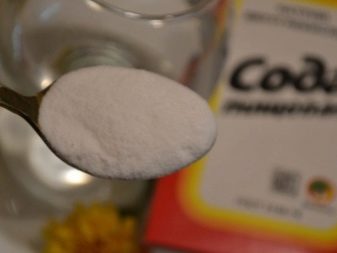

- A concentrated solution of laundry soap in water helps with baby urine (and not only baby urine). Alternatively, blot the stain immediately with a tissue, rubbing alcohol or mild citric acid on it. Or use any concentrated stain remover. Carpet products and liquid soap also help.
- A water solution of dishware applied with a sponge will relieve dirt from dirt, and to remove the remains of cosmetic cream, the same product must be mixed with soap.
- By dissolving the detergent and a couple tablespoons of vinegar in water, you can easily remove beer marks. The vinegar will remove the smell. But red wine can be wiped off with a cloth soaked in a mixture of vodka and salt. Alternatively, it is immediately soaked, cleaned with a cloth soaked in salt water. White wine is perfectly cleaned with a cotton pad soaked in alcohol.
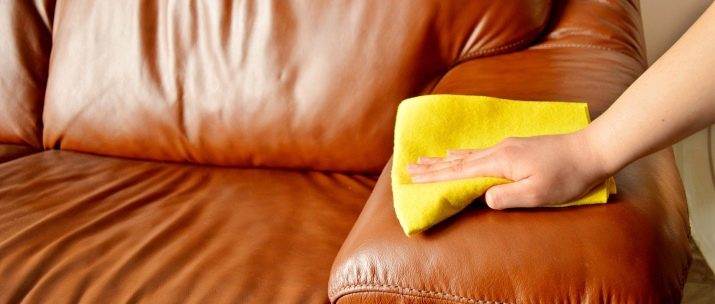
- Mold is removed first with a dry cotton pad moving from the border to the middle. Then the lesion is treated with a solution of alcohol, rubbed with one drop of vegetable oil. After 1/3 hour, you will need to blot the excess with a napkin.
- The chocolate is cleaned with toilet or liquid soap. It is advisable to dry the stains from it, as well as from jam, preserves and condensed milk, so that the dirt does not smear. Then the crust is removed and the remaining trace is washed off with soap. Chalk, talcum powder or salt will help to remove the fat (with an exposure time of two hours), then the sorbent is removed with a vacuum cleaner or a napkin.
- Juice stains are removed with an aqueous solution of ammonia or its mixture with an equal amount of vinegar. If you don't have such substances in your home, they can be easily replaced with nail polish removers, acetone, and any kind of alcohol. But don't forget about the safety of the drugs you choose.
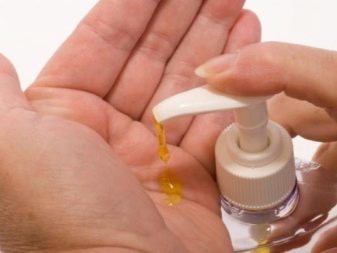

- The ink can be easily removed with bleach and laundry soap. It is not difficult to do without divorces, only elementary care is required; do not pour a lot of water, do not try to create a powerful foam head, clean the entire surface at once, not just one spot by itself. Instead of bleach, you can use table salt, baking soda, and citric acid.Put some salt in soapy water and wipe the affected part of the sofa with the solution, hold the stain under this layer for about five hours. Then the salt is removed, swept away, and the spot area is immediately wiped with a dry cloth.
- If you use citric acid, you will need to work with soapy water afterwards. Baking soda is used in the amount of a teaspoon per 500 grams of water.
- A ballpoint pen and gel paste can also work well with rubbing alcohol, but rub in gently and lightly. Otherwise, instead of removing the stain, you simply smear it over a larger area. Try to change cotton swabs soaked in liquid as often as possible.
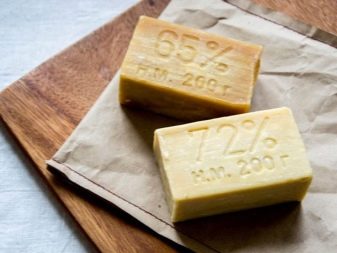
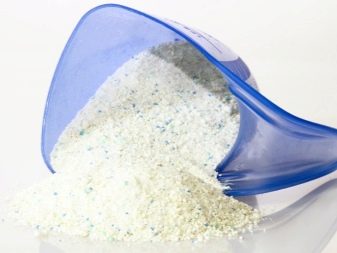
- The felt-tip pen can also leave marks on the sofa. These stains remove alcohol, acetone, nail polish removers, hair sprays, window cleaning sprays. A small portion of the liquid is applied to a cotton swab, the stain is blotted with it so as not to touch the clean places. After 40 minutes, wipe off the dirt with brushes (hard sponges), which are moistened in water or (better) soap suds. Fresh marks left by writing implements, including a highlighter, will help remove a stationery eraser. But be careful not to wipe a hole in the upholstery!


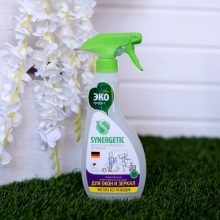
- Plasticine is removed in the same way as chewing gum - which is possible, peel off with a hard object. The remaining traces are sprinkled with salt, which will absorb some of the dirt. You can then wash the stain with soapy water or stain remover. It is strictly not recommended to remove gouache with gasoline, kerosene or turpentine, as in the case of floor coverings. It is better to use household cleaning products or soap suds.
- Dirt left by fried meat (fish) or mayonnaise should be sprinkled with baking soda for 1 hour, then wipe it off, wipe with a cloth soaked in alcohol. If there is no soda, it is replaced with starch or even plain salt. Soapy water rubbed in with a sponge will help to remove dried oily traces; the solution is washed off, if necessary, the procedure is repeated.
- If ointment gets on the upholstery, this problem is completely solvable; most of the ointments are cleaned in the same way as ordinary greasy stains. Beer and coffee are immediately soaked with a napkin, then the dirt is rubbed with a solution of soap and vinegar.
- Dr. Beckmann is able to eliminate the most stubborn stains from juices and green grass, from cocoa and fatty foods.

Knowing these simple principles, you can do it yourself to remove 95% of all dirt that may appear on the surface of the sofa. But it is also necessary to take into account the properties of the upholstery itself, so as not to use obviously unusable and dangerous means out of ignorance.
We clean by type of fabric
Cleaning methods:
- Leatherette can only be cleaned with very soft brushes, and ideally should be limited to a sponge. The velor sofa is allowed to be cleaned only with substances as gentle as possible; to apply them, use a damp cloth or a special napkin. You need to move strictly in the direction of the pile, any excess moisture should be removed immediately.
Best used for cleaning with microfiber cloths. Never press hard, otherwise the pile will be easily deformed. It is recommended to remove animal hair, hair and other small debris with brushes. If you find a difficult spot, it is advisable to contact a professional
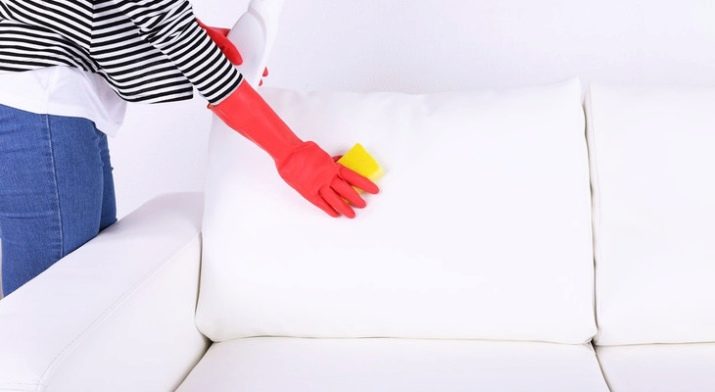
- Jacquard sofa requires the most careful work, do not forget that it needs to be dried with a foam sponge. If the fabric is not so capricious, it is allowed to blot it with paper towels. Unimax Ultra will reliably and safely clean iodine and coffee, brilliant green and tea stains from any upholstery, traces of contact with cosmetics. Amway upholstery and carpet compound can be used regardless of pile length. It is "friendly" with synthetic materials, but not suitable for processing velvet.
- Textile sofa Vacuum clean with a soft brush and medium power.
- Upholstery made of velvet and plush cannot be cleaned with soapy water or even clean water.It is allowed to apply one foam to it, you should move along the course of the pile. From available tools, you can also use alcohol or gasoline for lighters (in no case car lighters!).
- Wash upholstery from suede possible, but be careful not to over-wet the fabric. Tapestries do not tolerate wet cleaning at all; it is recommended to vacuum them dry. You can prepare a shampoo solution, but only the foam itself is carefully selected from it.
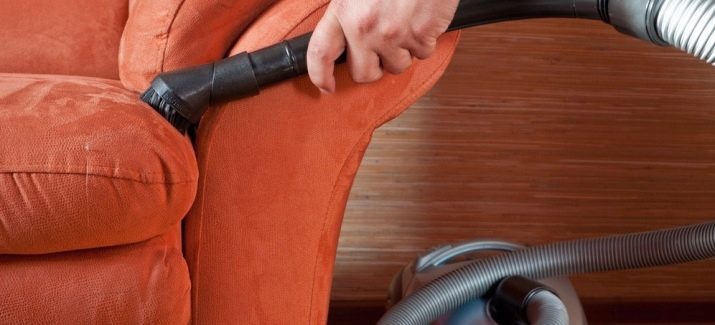
- Nubuck and suede are best cleaned with soft sponges, sometimes soft bristled brushes can be used, but be careful. An eraser will help to wipe the grease stains; they are also removed with rock salt and an aqueous solution of alcohol. It is advisable to apply a hydrophobic impregnation, it will protect the suede upholstery from moisture and reduce the resistance of many contaminants.
- If your sofa is covered vinyl, a vacuum cleaner will do the trick too, and just about any cleaning compound can be used. But don't mix them up. A leather sofa must be wiped with a damp cloth, any detergent is applied only in the form of a weak solution and is immediately washed off after use. It is generally recommended to treat leather and leatherette with a solution of soap and soda with a sponge, it is completely safe.
- Never wet skin too much: if possible, buy special wipes to care for her. If the upholstery is cracked and faded, beaten egg whites, which are applied with gauze or cotton cloth, will help correct the situation. Regular milk serves as a substitute for protein. Stains left by pens and felt-tip pens are cleaned off with alcohol or tape. Dust spots are removed from the skin with a soapy solution (a teaspoon of the product per liter of water, a sponge is moistened in this solution). After cleaning and wiping dry, lubricate the damaged area with glycerin. Most types of dirt are removed with petroleum jelly or baby oil, then the sofa must be wiped with a damp cloth.
- Furniture matting Vacuum should be done once a week; bleach, especially those containing chlorine, should not be used. If dried food is found on such a sofa, it is not scrubbed, but soaked and carefully washed with sponges, necessarily across the fibers. Drying should take place by itself, it is forbidden to speed up the process with a hair dryer or hot objects. Particularly stubborn stains are cleaned with alcohol or ammonia.
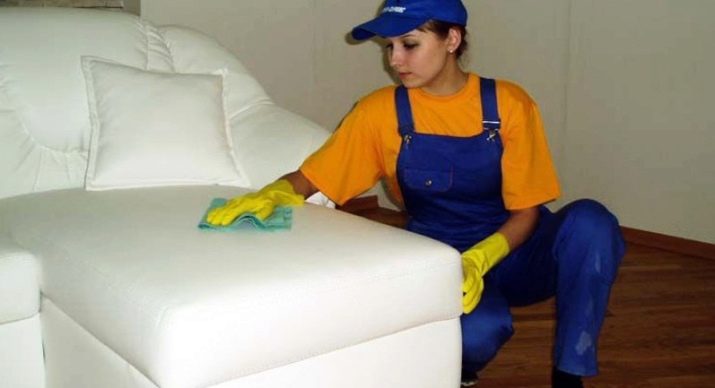
- Textile sofa can be cleaned with laundry soap, dishwashing detergents (but not abrasive!); it is also worth looking into the instructions and accompanying documents to find out which methods the manufacturer recommends. Light-colored fabric must be washed as a whole, even if the stain is quite insignificant.
- Lather from fabric surfaces removed with clean, damp sponges. The dried blood stain will go away from the rag sofa if you pour a little dish detergent into the water, soak a dirty place with this solution, and after a while rub it with a toothbrush.
- Flock sofa, as well as any other that has a pile, they are cleaned with vacuum cleaners with special attachments. A white textile sofa is cleaned with ordinary stain removers, but if there is a lot of dirt, then it is better to seek help from a dry cleaner.
Try to always remove dirt not only from the surface, but from the filler too. When someone sits down, the foam crumples, and dust particles stick to the upholstery from the inside. You can remove such dust by knocking out the upholstery with a stick or using special crackers. Be sure to cover the surface with a slightly damp sheet so that dirt does not scatter around the room and on the sofa itself.
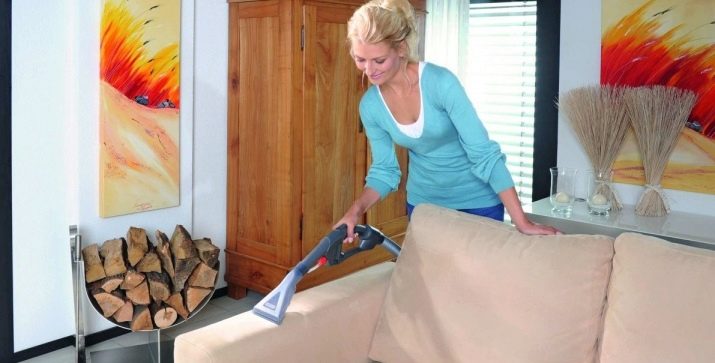
- Sofas from polyester, as well as flock (created on its basis) must not be cleaned with alcohol and everything that contains alcohol, except for very weak solutions. Any organic solvents and petroleum products, chlorine and mixtures containing it, scraping off stains also fall under the ban.
Eliminate the smell
Removing the smell of socks or any other unpleasant "odor" is very easy.Dilute laundry soap in water, and after cleaning the stain, wipe the place where it was with water mixed with aromatic oils or dishwashing gels containing perfume components.
The odors left by any drink are removed with furniture shampoos. The drug is used strictly according to the instructions, then the sofa must dry. Acetic acid solution (60 grams in a liter of water) removes the smells of beer and fruit juices well from available tools. The dirty area is completely covered with a piece of cloth, thoroughly moistened and slightly wrung out, then pressed to the surface. Most often, such processing is done repeatedly, and you shouldn't be afraid of the vinegar smell, it will go away in two or three days.
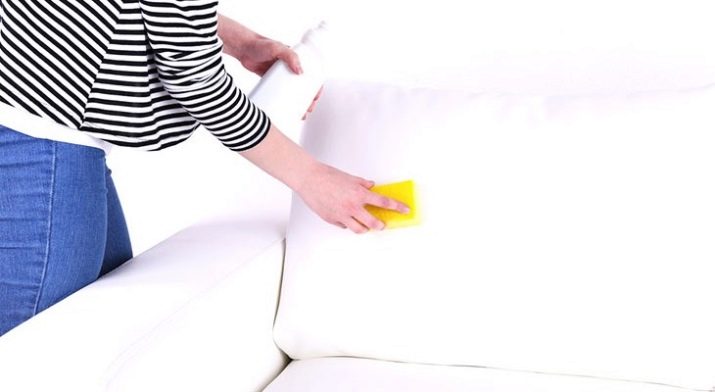
The smell of urine can be muffled with iodine: dissolve 20 grams of alcoholic tincture in a liter of water, and not only clean the upholstery, but also try to soak the filler as deeply as possible. If the sofa is light, it is more correct to clean it in this case:
- vinegar water;
- lemon juice (dilution 4-6 tablespoons per liter);
- potassium permanganate (its unsaturated solution).
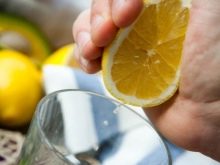
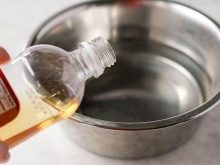
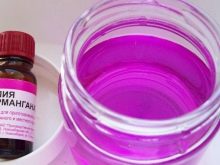
If the "hooliganism" is committed by a pet, it will take a long time to clean. The upholstery is moistened with a solution of nine percent vinegar in three parts of water, then dried. After drying, sprinkle with soda and spray with an aqueous solution of hydrogen peroxide (50% concentration). The drug forms a copious foam, this is completely normal, after three hours the remaining dirt is removed with a damp cloth, the sofa is dried. Soda is vacuumed or brushed off.
Deep-seated odors will have to be cleaned out twice, with the addition of fabric softener. Cat litter will provide some help in the fight against unpleasant odors, it is especially effective on flock upholstery. Spread the reagent over the surface and leave for about thirty minutes, then collect and discard in the trash can. The sofa itself will need to be lightly vacuumed.
Even very stubborn odors can be removed by ventilation. No, there is no need to open windows and doors for many hours in a row. Just wait for the good, cloudless weather and put the sofa outdoors. By evening it will be completely clean and fresh.

Getting rid of grease
Returning greasy furniture to its normal state is not so difficult. Prepare this preparation:
- A couple of glasses of water.
- 60 grams of salt.
- A teaspoon of washing powder.
Having placed all this in one container, mix thoroughly, apply the solution and wait ¼ hour. Then rinse off what remains and dry the area of the former stain. Glossy marks are removed from dense coatings with a sponge soaked in a solution of soap and soda or detergent. The lint-free upholstery must be cleaned in the same ways, first the spots themselves are smeared with foam for ten minutes, then it is washed off with clean water and the surface is dried by touching the fabric.
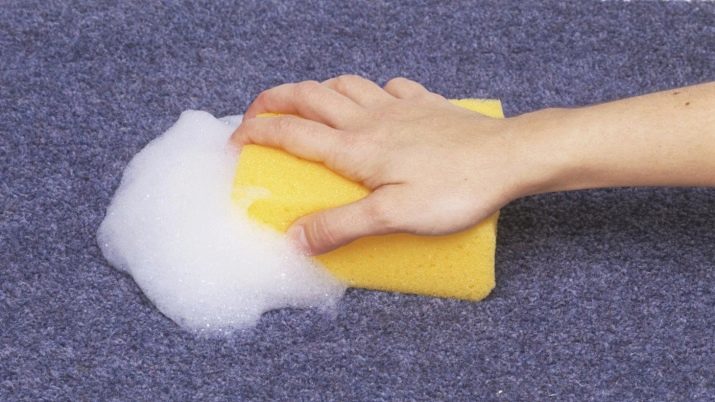
If it was not possible to immediately remove the shiny stains, re-treat them, and to avoid the appearance of a halo, prepare a less saturated solution and clean the entire surface of the furniture with it. Greasy areas can be wiped with a half of an onion, while its surface must be cut off as it gets dirty and dries up. After cleaning, the upholstery should be wiped with a dry soft cloth. And be sure to ventilate the room right away.
Less "fragrant" but just as effective is regular toothpaste. A small amount of it with a brush is applied to the stain and rubbed without pressing. Then use a damp cloth to wipe off any excess product and do not use the sofa until it is dry. It is best to take baby toothpaste, and if using an adult, make sure that it does not contain foreign inclusions.
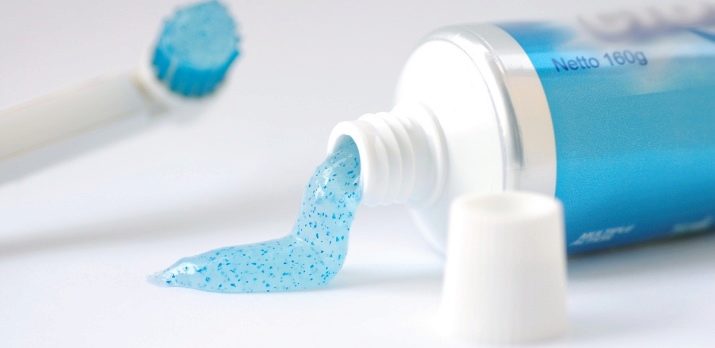
We clean wooden armrests
The armrests must be cleaned, if mugs of hot drinks have been placed on them, then petroleum jelly will help. Rub the white marks with it, and after a few hours you will not find the slightest sign of a stain.If someone ill-mannered stuck chewing gum on the armrest, rub a little of the same petroleum jelly into it, very soon the lump will shatter and crumble.

How do I wash the cover?
The sofa cover will "take over" the dirt and prevent it from getting onto the upholstery. But this means that its surface gradually becomes unsightly in appearance. With normal use, the covers are washed every three or four months, however, active children, pets in the house make this need much more frequent. A vacuum cleaner with furniture attachments will get rid of dust, or the fabric is knocked out like a carpet. A very dirty cover can be properly cleaned in a dry-cleaner; you should go there for any serious contamination.
If, nevertheless, the decision is made to clean the covers at home, you will have to spend a lot of time. Set the program short, otherwise the seams may loosen or the material will deteriorate. Please note that it is unlikely that you will be able to wash the cover yourself at a time; after washing, carefully inspect it, and if there are stains, stripes, repeat the treatment. It is useful to treat all dirt with a stain remover according to the instructions before sending the product to the washing machine.
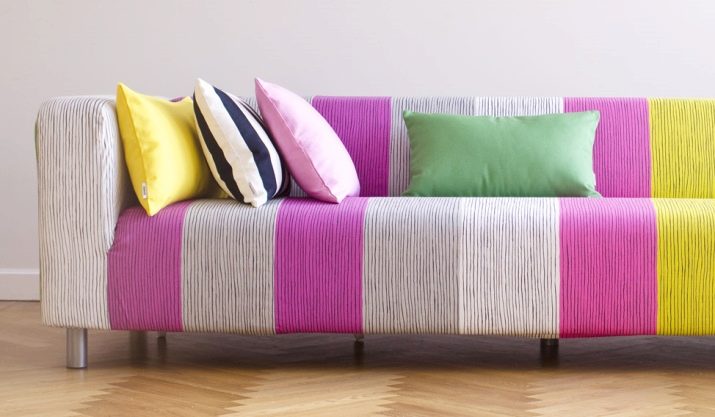
The old cover can only be washed if the fabric is not too worn out. Otherwise, you should nevertheless turn to professionals, they know exactly how to carry out gentle cleaning and remove all blockages.
Hidden places, if the whole problem is only in them, can be put in order with the help of a steam cleaner. But carefully read the label: maybe high-temperature processing is contraindicated for the product!
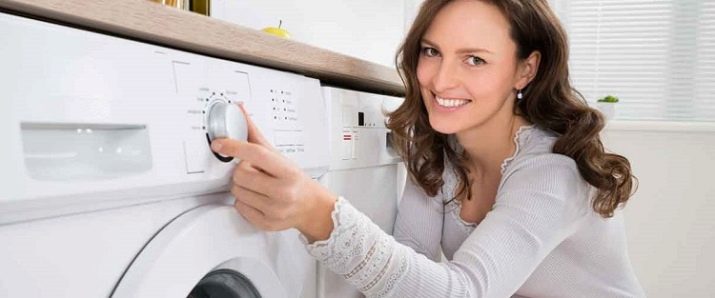
Tips and tricks:
- If you want to restore the usual color to your sofa, use any carpet cleaner and stir in some acetic acid. The resulting product also effectively fights against stains and bad odors. When vacuuming the sofa, be sure to use a narrow nozzle (to clean corners) or a special nozzle for working with upholstered furniture.
- To fight dust and other dirt less, simply buy a special case. And still, you will need to clean the surface at least once a week, even if not a sofa, but a cover.
- It is easy to remove old coffee and tea stains with a soapy solution of three drops of any detergent and a couple of tablespoons of acetic acid in a liter of warm water. If they are fresh, you can dissolve 1-2 tablespoons per glass or use regular laundry soap. Please note that the first method should be used carefully on dark fabrics, they may fade.
- Before using any cleaning agent (store or homemade), take care of covering the floor and other furniture. Otherwise, it may turn out that for each stain removed from the sofa there will be several planted in other places. It is recommended to clean the sofa, starting from the back, then moving on to the armrests, seat, and finishing the process by processing the lower part of the product. It is best to consistently clean areas of about forty by forty centimeters.
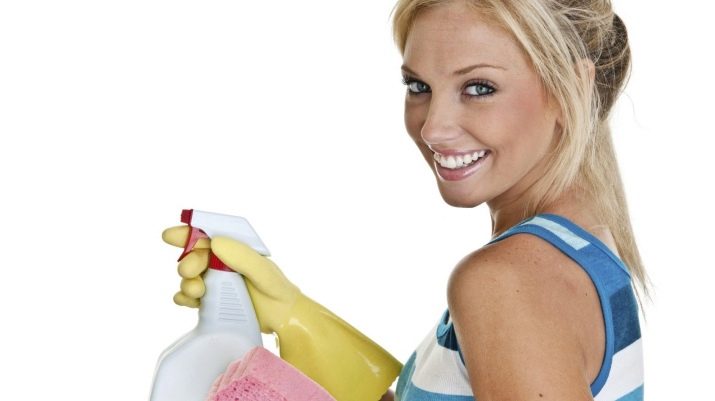
- The cleaning composition is introduced into each area in about half a minute, this is enough both to penetrate deeply, and to start a reaction with the most stubborn dirt. If coffee or tea gets on colored upholstery, the concentration of the preparations should be reduced in comparison with the usual situation. Better yet, take a 10% borax solution and use it, it's completely safe.
- Never try to cleanse blood with hot water, the proteins that form it will clot up and make the stain even more difficult to remove. The cleaning agent is not applied to the upholstery itself, but to the brush you will be using.
- To get rid of dirt on white skin will help the most ordinary milk (best of all, minimum fat content): cotton wool is soaked in it and the surface is rubbed. If you've used ammonia, apply glycerin or castor oil immediately afterward to keep the leather surface from drying out.
- If wax gets on the surface of the sofa, it can be removed with an iron and absorbent paper. First, the outer part of the stain is scraped off, then paper is applied and ironed on it with a moderately heated iron.

In no case go beyond the borders of the sheet! Note that the gasket will most likely need to be changed several times until the dirt is removed. Then you will need to wipe the affected area with a swab with alcohol.
- To soak up moisture from the surface of the sofa, you can use not only napkins, but also waffle towels. Reducing the risk of upholstery clogging is easy: Avoid eating or drinking any beverages on the couch. Never place sofas, especially leather sofas, next to radiators or other heating appliances, directly under air conditioners.
- Do not put colored pillows or any objects with unstable dyes on the sofa: if they get on the upholstery, you will not be able to do anything with your own hands.

By strictly following these guidelines, you can avoid the vast majority of contamination. And if they do appear, you can almost certainly cope, regardless of the type of sofa upholstery and the age of the stain.

For more tips on how to clean your sofa at home, see the video below.









Great article! Thanks to you, I ordered the cleaning of the leather sofa at home.